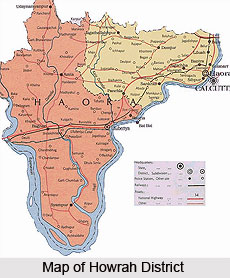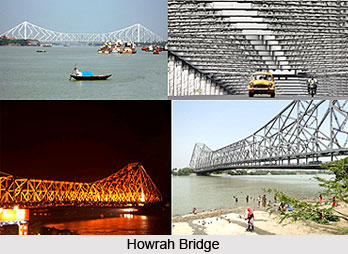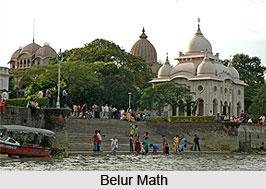 Howrah is one of the administrative districts of the state, including the city itself and the adjacent areas. The city came to be existed functionally as a separate administrative unit in the end of 1937. The second largest city of West Bengal lies along the west bank of the Hooghly River. As far as the history is concerned the present district of Howrah has owed its name from the name of a village called "Harari" existed in the 18th century.
Howrah is one of the administrative districts of the state, including the city itself and the adjacent areas. The city came to be existed functionally as a separate administrative unit in the end of 1937. The second largest city of West Bengal lies along the west bank of the Hooghly River. As far as the history is concerned the present district of Howrah has owed its name from the name of a village called "Harari" existed in the 18th century.
History of Howrah District
The past history of Howrah can be traced in the accounts of the ancient pundits. According to those pundits, the history of Howrah is closely knitted with the ancient Sumha region of Rarh and the southern part of this Sumha was constituted with the present region of Howrah and Midnapore.The hearsay is that Bhurisrestha, an ancient kingdom, which existed even before the arrival of the British East India Company comprises some of the areas of present district of Howrah. Finally, it was the British who consolidate the broken parts and constitute a separate administrative district of Howrah, while subdividing Bengal into Presidency, Bardhaman and Jalpaiguri division. .The history of Howrah therefore represents the verity that, the present district of Howrah is an amalgamation of the disintegrated parts scattered all over.
Demography of Howrah District
As per the demographic survey of 2001, Howrah comprises of about 1,008,704 population, of which 54% consists of male and 46% females. Howrah has an average literacy rate of 77%, which is even more than the national average. About 81% male and 73% of female are literate. About 9% of population is below 6 years of age.As the economy is prevalently industrial, majority of populace draw living from the industries. Only 30 % of people engaged in cultivation. The eminent demographers have pointed out that the majority of areas have urban set up. Till 1998, about 755 villages facilitated with electricity. There are about 28 hospitals and 59 health centers throughout the district. Primarily a Hindu District, some Muslims are also found locally. Though Bengali is largely spoken, the local Muslims speak Hindi and Urdu.
Education of Howrah District
 The education in the Howrah district has a sound basis since its advent. According to the unexcavated fact, the Sanskrit Literature once attained popularity. The relics of the Sanskrit "tolls" are found in the extensive areas of Bally, Belur and Amta. However the existing "Chatuspathis" are provided with Government aid for the promotion of the Sanskrit language.
The education in the Howrah district has a sound basis since its advent. According to the unexcavated fact, the Sanskrit Literature once attained popularity. The relics of the Sanskrit "tolls" are found in the extensive areas of Bally, Belur and Amta. However the existing "Chatuspathis" are provided with Government aid for the promotion of the Sanskrit language.
The Baptist Missionaries initiated the convent education in Howrah. Recently there are several schools affiliated to both West Bengal and I.S.C.E and C.B.S.E. Narasimha Dutta College was the first college, established in 1923 provide the courses of B.A, B.S.C and B.COM. Presently there are clusters of colleges in the district to provide these general courses, of which some are Government undertaken and some are private enterprises.
The first Girls` College in Howrah, which initiated the higher education of the girls here, was brought under the jurisdiction of Calcutta University in the year of independence.
The vocational trainings are also emphasized to cope up with the rapidly changing world. The vocational learning also ensures the educational development. Presently there are some drama and music schools of superior quality in Howrah.
Culture of Howrah District
Howrah is mainly populated with the Hindus; hence the culture of the land essentially follows the Hindu cult. The festivals and the lifestyle in the district utter the Hindu Culture prevalent in the region.The people of the Howrah region intensely believe in the divine power of Devi Chandi.Even there is a common belief that the land has been formed by the blessings of Devi Chandi. However people in the interior zone also worships certain demigods. Rashmela of Uluberia, Durga Puja Mela of Fort Gloster, fairs in Kalyanpur, Baniban and Bagnan on the occasion of the Gajan etc. are some of the fairs representing the prevalence of the Hindu Culture.The culture of "Para" or neighborhood is very common in the region. The leisurely chat or locally called "Adda" is popular here. Rice and fish are the traditional favorite.Howrah, an industrially developed district represents an urban set up with a sound basis of socio-economic and educational foundation.
 Tourism in Howrah District
Tourism in Howrah District
In the industrial district of Howrah, however tourism does not find a congenial atmosphere to develop. Historically the district is not significant enough, henceforth, the dearth of the interesting site and significance has an adverse effect to the growth of the tourism in Howrah.
However tourism has developed in Howrah pivoting the Belur Math and the Botanical Gardens. The renowned attraction in the Belur Math is the Ramakrishna Temple. The lovely lawn and the headquarters of Ramakrishna Mission are amazing. The Math also aided a number of educational institutions. During the different occasion regarding Lord Ramakrishna and even in the festival of Durga Puja, pilgrims gather here. Moreover, a mass of alien travelers visited here all through the year. Belur Math, the religious seat is the prominent site, which helps in the development of the tourism here.
The great Indian Banyan tree is the special attraction in the Botanical Gardens at Shibpur. The diversified flora in the Garden cast a spell to the tourist. The botanists and the lovers of nature will find their staple source of enjoyment in the garden. The Botanical Garden is the oldest one of its own kind still existing. Besides, some small temples are scattered here and there, which constitutes the important tourist centers here.The Belur Math and the Botanical Gardens constitute the tourism of Howrah.






